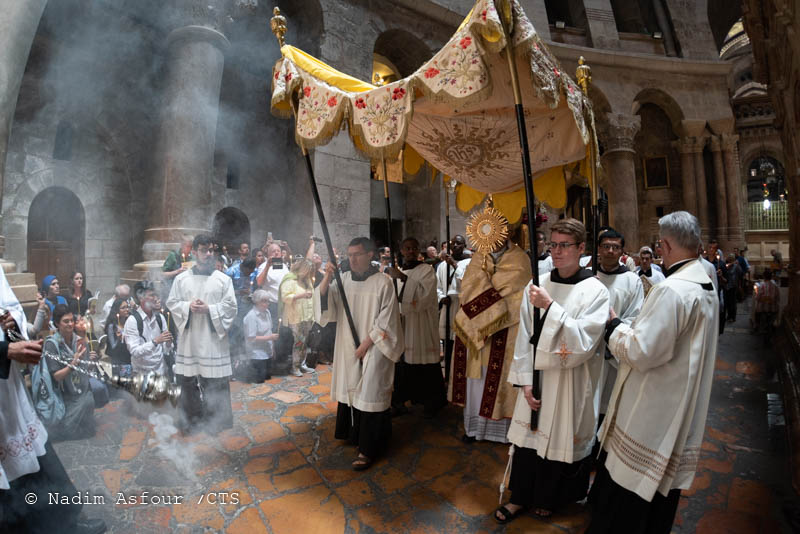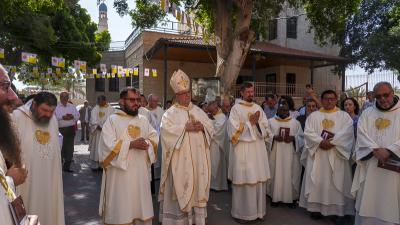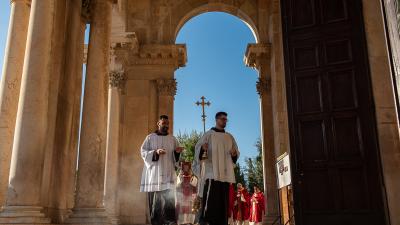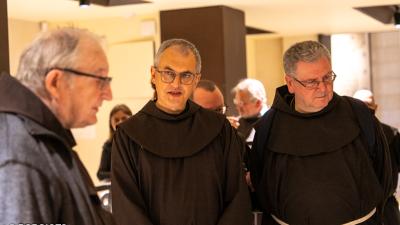
On May 31, a big feast took place at the Holy Sepulcher. According to ancient tradition, the Church of Jerusalem celebrated Corpus Christi, which is one of the most important solemnities celebrated at the Basilica of the Resurrection. It is the feast of the real presence of Jesus Christ in the Eucharist, which reminds us of the importance of this sacrament and of Christ’s gift, offered as a sacrifice for us. This solemnity, which was a local tradition in Belgium in 1247, was placed in the liturgical calendar for the Universal Church a little less than 800 years ago, in 1267, by Pope Urban IV. This occurred at a time when the doctrine of the real presence of Christ in the Eucharist was being heavily doubted. This was explained by the Apostolic Administrator of the Latin Patriarchate in his homily during the solemn mass for the feast.
Beginning on the previous day, however, celebrations at the Holy Sepulcher had already begun. The Franciscan friars of the Custody of the Holy Land on the vigil of the feast of Corpus Christi went to the Latin Patriarchate to invite the Apostolic Administrator of the Latin Patriarchate to make his solemn entry into the Sepulcher. In the early afternoon, before the Holy Edicule, they celebrated the first Vespers for the feast. Then came the time for the daily solemn version of the procession at the Holy Sepulcher, with the presence of the Blessed Sacrament, at the very place where the Body of Christ was laid and where he rose.
After singing Morning Prayer, Mons. Hanna Kildani, the Patriarchal Vicar for Israel, recalled the priesthood anniversaries of various priests who were present. In particular, Mons. Kamal Bathish and Mons. Giacinto Boulos Marcuzzo, who were celebrating their 25th year of ministry, while Mons. Bader celebrated his 10th anniversary.
“On today's solemnity we read the same Gospel that the Church proclaims on the evening of Holy Thursday, remembering the Last Supper, which brings us back to the days of the Passion,” said Pizzaballa in the homily. “Jesus offers his body and his blood, which are his life; he offers it in an extreme gesture of love, as a sign of the covenant, as food for salvation, as a principle of new life for everyone.”
The Apostolic Administrator explained that the Eucharist is a gift that people should be prepared for and the same applies to priests. “Only after years of celebration, only after having experienced the initial joy, fatigue and loneliness but also the consolation of the ministry, we can better understand and listen with greater awareness to the greatness of the mystery that we celebrate. In the Eucharist, love is real food.”
The Eucharist is not only an occasional gesture, but it is a “way of being part of life, taking it in our hands, as it is, so as to offer it as a gift, to give it [to others] and give it back,” said Pizzaballa.
As with all the solemn feasts, a procession was held which made its way around the shrine of Christ’s Sepulcher three times. Protected by the baldachin, Mons. Pizzaballa carried the Blessed Sacrament in his hands, followed by friars, priests and the faithful. The Tantum Ergo Sacramentum was sung three times at the end of the celebration.
Beatrice Guarrera
05/31/2018




